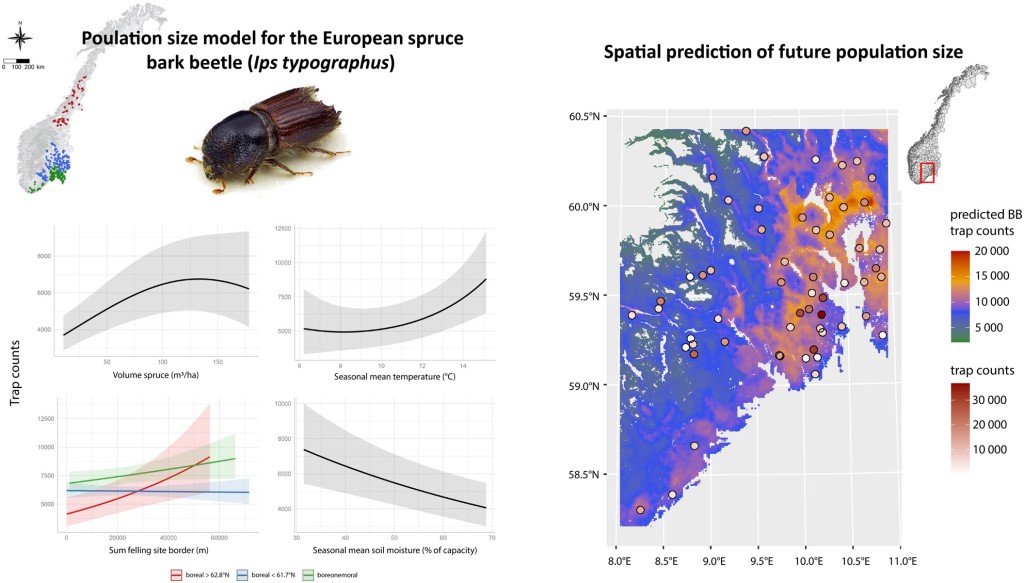In this week’s blog post, Jostein Gohli and authors discuss their recent research which explores how climatic and management-related factors influence bark beetle population sizes in boreal forests.
The European spruce bark beetle
The European spruce bark beetle (Ips typographus) is a notorious tree-killer in spruce-dominated forests. The last 5-10 years it has caused enormous problems in Central Europe, killing hundreds of millions of spruce trees. In Europe’s northern boreal forests, the beetle is ever-present but has a more limited impact, with only sporadic bursts of tree-killing. Although Norway has not had a major bark beetle outbreak since the 1970s, increases in both beetle numbers and tree mortality have foresters worried for what the future might hold.
Ips typographus is unique in that, when the beetles become sufficiently numerous, they can collaborate and overcome the defences of perfectly healthy spruce trees. When this critical density threshold is surpassed, it may initiate large self-sustaining outbreaks that can result in millions of dead spruce trees.
Non-outbreak beetle populations: A useful study system
In a recent study in Journal of Applied Ecology, we analysed trapping data from the Norwegian bark beetle monitoring, using a 17-year period with no bark beetle outbreaks. This allowed us to examine environmental factors that are important for driving bark beetle numbers towards the outbreak threshold.
When beetle numbers are low, a bark beetle can be likened to a hungry person in a full pantry with no can opener; the defences of healthy spruce trees are simply too powerful for a few beetles to overcome. However, when the beetles become more numerous and surpass the outbreak threshold they are no longer restricted to feeding on dead or weakened trees. Under such circumstances, very different population dynamics come into play.
Since there has not been any outbreak in Norway since the 1970s, the monitoring data we analysed is well suited to identify drivers influencing bark beetle numbers under non-outbreak conditions. By identifying these factors and mechanisms we can thus better understand the risks of outbreaks initiating.
Environmental factors that increase bark beetle numbers
Unsurprisingly, we found that the amount of spruce in the landscape is an important determinant of bark beetle numbers. We also observed that more newly exposed stand edge after clear-cutting is associated with higher beetle numbers. The reason for this is probably that spruce trees along stand edges are weakened by the sudden exposure to sun and wind, making them suitable hosts for bark beetle reproduction.
Furthermore, we found both temperature and drought to be important, with beetle numbers being higher after hotter and dryer periods. Temperature is determining the developmental rate of all “cold-blooded” (or ectotherm) animals, insects included. The effect of drought resembles that of stand edges since drought weakens the spruce trees. Perhaps most interestingly, we observed a clear time delay in how some of these environmental factors influenced bark beetle numbers.
Our analyses show that there is typically a 3-year delay from a disturbance, such as the exposure of a new stand edge, until bark beetle numbers peak. Similarly, a severe drought is expected to cause high bark beetle numbers three years later.
Predicting the future
Our model can be used to predict future bark beetle numbers across entire landscapes. This is a very useful tool for forest managers, since higher beetle numbers are associated with a higher risk of forest damage. Due to the time delay described above we can use current environmental data and predict bark beetle numbers three years into the future. This useful feature can be used to direct logging activities to high-risk areas with high beetle populations, among other things.
How can we prevent beetle damage?
Forests worldwide are under increasingly strong pressure from natural disturbances. While the situation at more northerly latitudes is currently less dire, climate change projections tell us that this probably will not last. It is also important to consider the slow-paced nature of forestry at northern latitudes; spruce trees planted today will not be harvested until the end of this century. Changes made to forest structure and management to mitigate effects of natural disturbances should thus be implemented sooner rather than later.
Our study highlights that a reduction in spruce densities would result in more resilient forests, and that creating hard forest edges within mature spruce forests should be avoided or minimized. Both reduced spruce densities and less hard edges can be achieved by switching to mixed forests and continuous cover forestry.
Read the full article “Climatic and management-related drivers of endemic European spruce bark beetle populations in boreal forests” in Journal of Applied Ecology.




